MITSUBISHI SHOGUN 2017 Owner's Manual (in English)
Manufacturer: MITSUBISHI, Model Year: 2017, Model line: SHOGUN, Model: MITSUBISHI SHOGUN 2017Pages: 394, PDF Size: 19 MB
Page 301 of 394
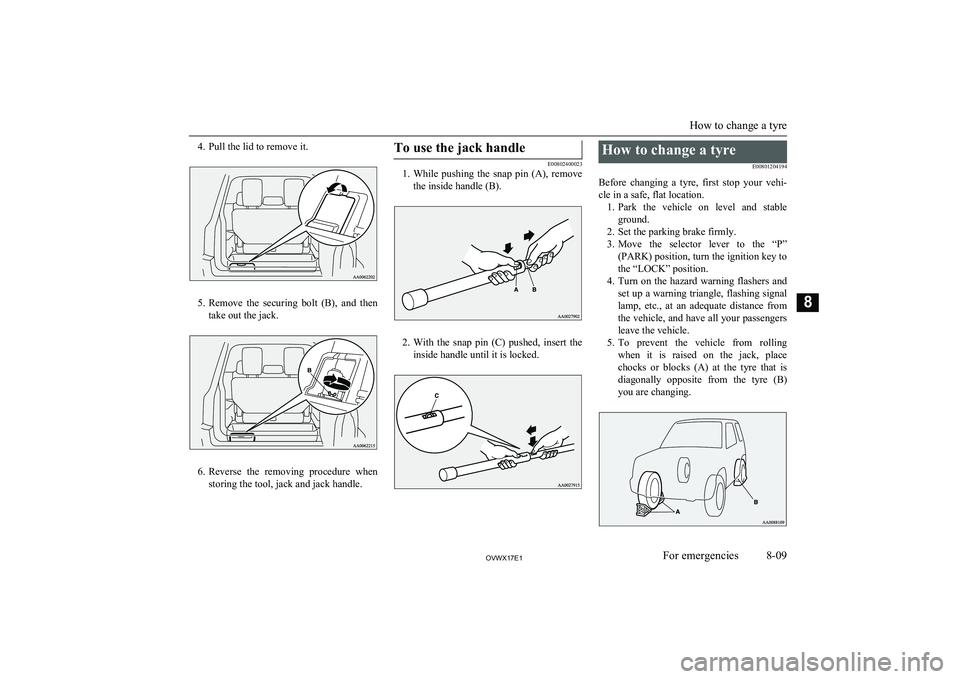
4. Pull the lid to remove it.
5.Remove the securing bolt (B), and then
take out the jack.
6. Reverse the removing procedure when
storing the tool, jack and jack handle.
To use the jack handle
E00802400023
1. While pushing the snap pin (A), remove
the inside handle (B).
2. With the snap pin (C) pushed, insert the
inside handle until it is locked.
How to change a tyre
E00801204194
Before changing a tyre, first stop your vehi- cle in a safe, flat location. 1. Park the vehicle on level and stable
ground.
2. Set the parking brake firmly.
3. Move the selector lever to the “P”
(PARK) position, turn the ignition key to
the “LOCK” position.
4. Turn on the hazard warning flashers and
set up a warning triangle, flashing signal
lamp, etc., at an adequate distance from
the vehicle, and have all your passengers
leave the vehicle.
5. To prevent the vehicle from rolling
when it is raised on the jack, place
chocks or blocks (A) at the tyre that is
diagonally opposite from the tyre (B)
you are changing.
How to change a tyre
8-09OVWX17E1For emergencies8
Page 302 of 394
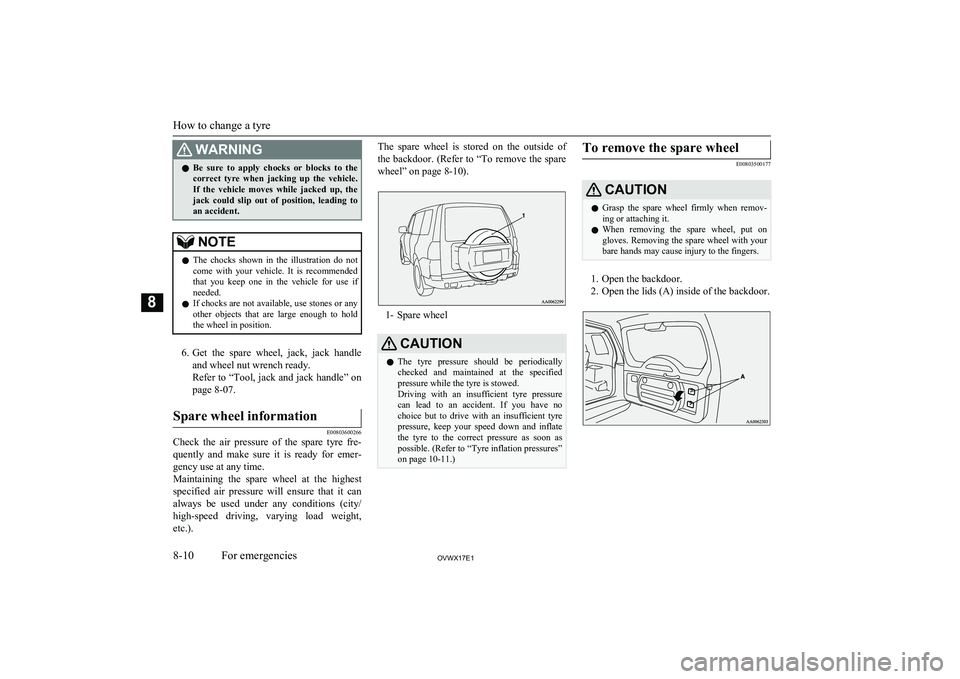
WARNINGlBe sure to apply chocks or blocks to the
correct tyre when jacking up the vehicle.If the vehicle moves while jacked up, the
jack could slip out of position, leading to
an accident.NOTEl The chocks shown in the illustration do not
come with your vehicle. It is recommended
that you keep one in the vehicle for use if needed.
l If chocks are not available, use stones or any
other objects that are large enough to hold the wheel in position.
6. Get the spare wheel, jack, jack handle
and wheel nut wrench ready.
Refer to “Tool, jack and jack handle” on page 8-07.
Spare wheel information
E00803600266
Check the air pressure of the spare tyre fre-quently and make sure it is ready for emer-
gency use at any time.
Maintaining the spare wheel at the highest specified air pressure will ensure that it can
always be used under any conditions (city/ high-speed driving, varying load weight,etc.).
The spare wheel is stored on the outside of
the backdoor. (Refer to “To remove the spare wheel” on page 8-10).
1- Spare wheel
CAUTIONl The tyre pressure should be periodically
checked and maintained at the specified
pressure while the tyre is stowed.
Driving with an insufficient tyre pressure can lead to an accident. If you have nochoice but to drive with an insufficient tyre
pressure, keep your speed down and inflate the tyre to the correct pressure as soon as
possible. (Refer to “Tyre inflation pressures”
on page 10-11.)To remove the spare wheel
E00803500177
CAUTIONl Grasp the spare wheel firmly when remov-
ing or attaching it.
l When removing the spare wheel, put on
gloves. Removing the spare wheel with your
bare hands may cause injury to the fingers.
1. Open the backdoor.
2. Open the lids (A) inside of the backdoor.
How to change a tyre
8-10OVWX17E1For emergencies8
Page 303 of 394
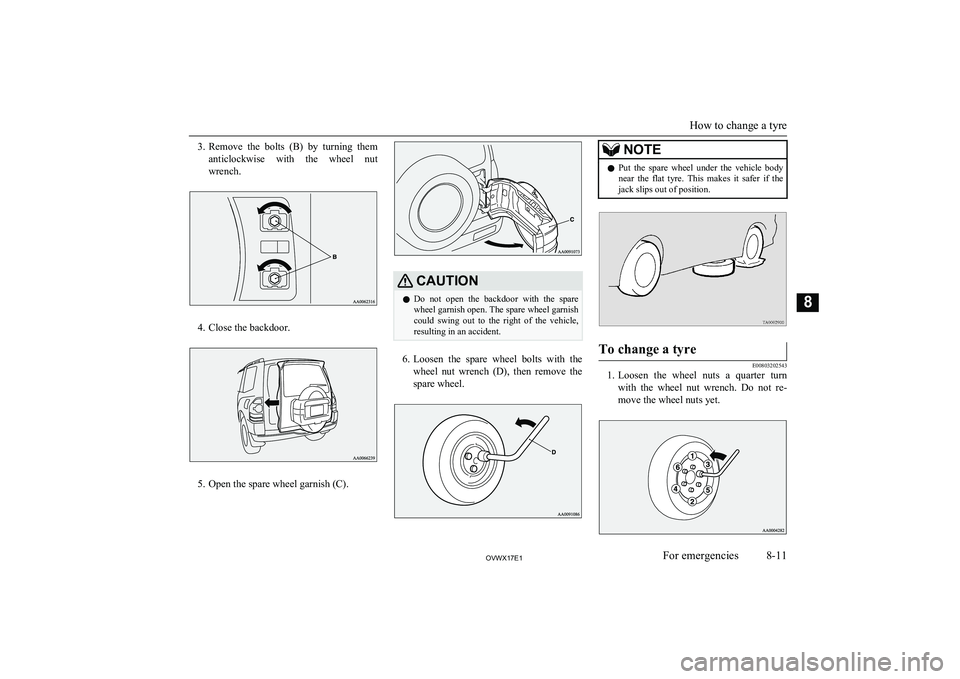
3.Remove the bolts (B) by turning them
anticlockwise with the wheel nut
wrench.
4. Close the backdoor.
5. Open the spare wheel garnish (C).
CAUTIONl Do not open the backdoor with the spare
wheel garnish open. The spare wheel garnish
could swing out to the right of the vehicle, resulting in an accident.
6. Loosen the spare wheel bolts with the
wheel nut wrench (D), then remove the spare wheel.
NOTEl Put the spare wheel under the vehicle body
near the flat tyre. This makes it safer if the jack slips out of position.To change a tyre
E00803202543
1. Loosen the wheel nuts a quarter turn
with the wheel nut wrench. Do not re- move the wheel nuts yet.
How to change a tyre
8-11OVWX17E1For emergencies8
Page 304 of 394
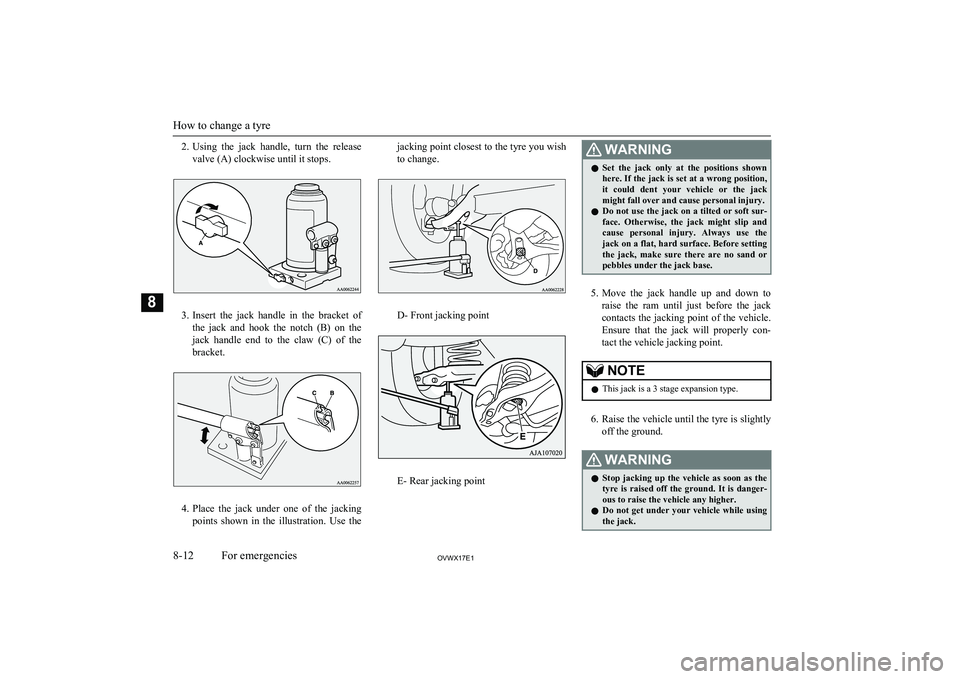
2.Using the jack handle, turn the release
valve (A) clockwise until it stops.
3. Insert the jack handle in the bracket of
the jack and hook the notch (B) on the
jack handle end to the claw (C) of the bracket.
4. Place the jack under one of the jacking
points shown in the illustration. Use the
jacking point closest to the tyre you wish
to change.
D- Front jacking point
E- Rear jacking point
WARNINGl Set the jack only at the positions shown
here. If the jack is set at a wrong position, it could dent your vehicle or the jack
might fall over and cause personal injury.
l Do not use the jack on a tilted or soft sur-
face. Otherwise, the jack might slip and cause personal injury. Always use the jack on a flat, hard surface. Before setting
the jack, make sure there are no sand or pebbles under the jack base.
5. Move the jack handle up and down to
raise the ram until just before the jack contacts the jacking point of the vehicle.
Ensure that the jack will properly con- tact the vehicle jacking point.
NOTEl This jack is a 3 stage expansion type.
6.
Raise the vehicle until the tyre is slightly
off the ground.
WARNINGl Stop jacking up the vehicle as soon as the
tyre is raised off the ground. It is danger-
ous to raise the vehicle any higher.
l Do not get under your vehicle while using
the jack.
How to change a tyre
8-12OVWX17E1For emergencies8
Page 305 of 394
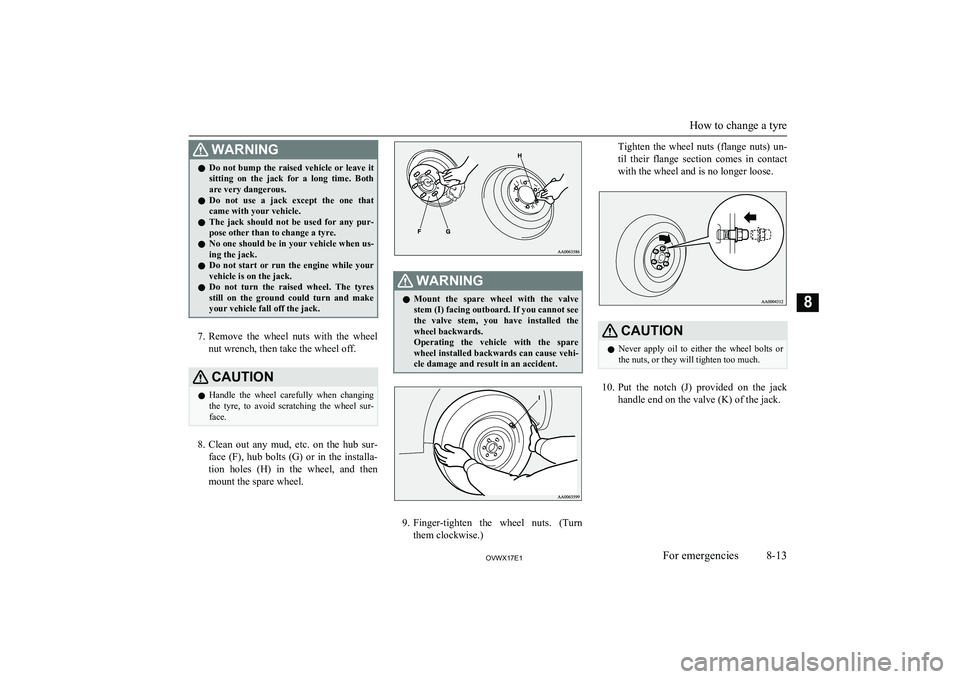
WARNINGlDo not bump the raised vehicle or leave it
sitting on the jack for a long time. Bothare very dangerous.
l Do not use a jack except the one that
came with your vehicle.
l The jack should not be used for any pur-
pose other than to change a tyre.
l No one should be in your vehicle when us-
ing the jack.
l Do not start or run the engine while your
vehicle is on the jack.
l Do not turn the raised wheel. The tyres
still on the ground could turn and make your vehicle fall off the jack.
7. Remove the wheel nuts with the wheel
nut wrench, then take the wheel off.
CAUTIONl Handle the wheel carefully when changing
the tyre, to avoid scratching the wheel sur- face.
8. Clean out any mud, etc. on the hub sur-
face (F), hub bolts (G) or in the installa- tion holes (H) in the wheel, and then
mount the spare wheel.
WARNINGl Mount the spare wheel with the valve
stem (I) facing outboard. If you cannot see
the valve stem, you have installed the wheel backwards.
Operating the vehicle with the spare
wheel installed backwards can cause vehi-
cle damage and result in an accident.
9. Finger-tighten the wheel nuts. (Turn
them clockwise.)
Tighten the wheel nuts (flange nuts) un-
til their flange section comes in contact
with the wheel and is no longer loose.CAUTIONl Never apply oil to either the wheel bolts or
the nuts, or they will tighten too much.
10. Put the notch (J) provided on the jack
handle end on the valve (K) of the jack.
How to change a tyre
8-13OVWX17E1For emergencies8
Page 306 of 394
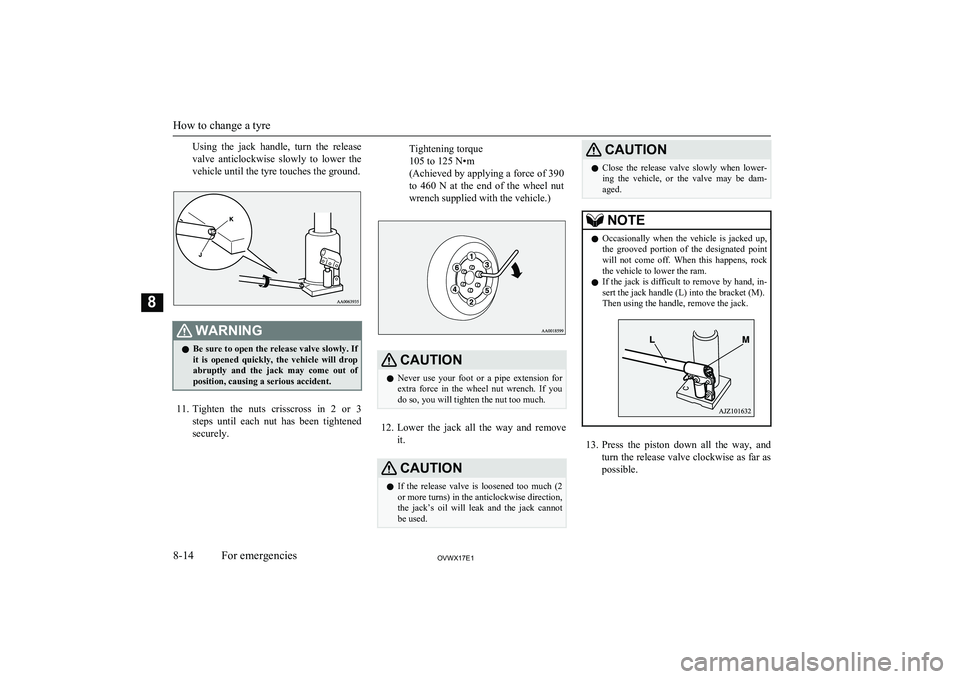
Using the jack handle, turn the releasevalve anticlockwise slowly to lower thevehicle until the tyre touches the ground.WARNINGl Be sure to open the release valve slowly. If
it is opened quickly, the vehicle will drop
abruptly and the jack may come out of
position, causing a serious accident.
11. Tighten the nuts crisscross in 2 or 3
steps until each nut has been tightened
securely.
Tightening torque
105 to 125 N•m
(Achieved by applying a force of 390
to 460 N at the end of the wheel nut wrench supplied with the vehicle.)CAUTIONl Never use your foot or a pipe extension for
extra force in the wheel nut wrench. If you
do so, you will tighten the nut too much.
12. Lower the jack all the way and remove
it.
CAUTIONl If the release valve is loosened too much (2
or more turns) in the anticlockwise direction, the jack’s oil will leak and the jack cannotbe used.CAUTIONl Close the release valve slowly when lower-
ing the vehicle, or the valve may be dam-
aged.NOTEl Occasionally when the vehicle is jacked up,
the grooved portion of the designated pointwill not come off. When this happens, rock
the vehicle to lower the ram.
l If the jack is difficult to remove by hand, in-
sert the jack handle (L) into the bracket (M).Then using the handle, remove the jack.
13. Press the piston down all the way, and
turn the release valve clockwise as far as possible.
How to change a tyre
8-14OVWX17E1For emergencies8
Page 307 of 394
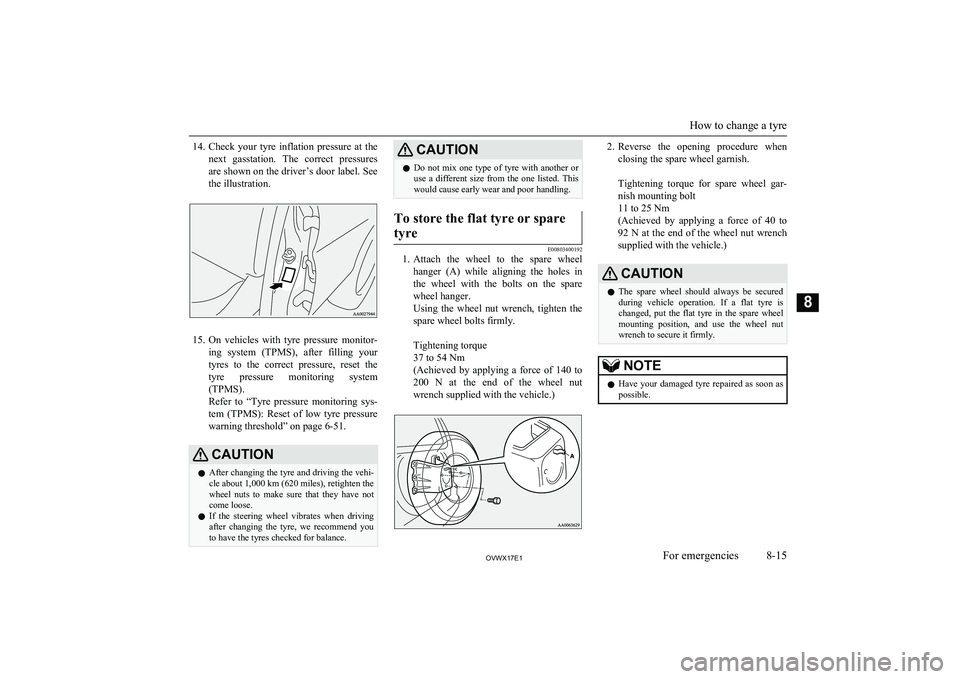
14.Check your tyre inflation pressure at the
next gasstation. The correct pressures
are shown on the driver’s door label. See the illustration.
15. On vehicles with tyre pressure monitor-
ing system (TPMS), after filling your tyres to the correct pressure, reset the tyre pressure monitoring system(TPMS).
Refer to “Tyre pressure monitoring sys-
tem (TPMS): Reset of low tyre pressure
warning threshold” on page 6-51.
CAUTIONl After changing the tyre and driving the vehi-
cle about 1,000 km (620 miles), retighten the
wheel nuts to make sure that they have not come loose.
l If the steering wheel vibrates when driving
after changing the tyre, we recommend you to have the tyres checked for balance.CAUTIONl Do not mix one type of tyre with another or
use a different size from the one listed. This
would cause early wear and poor handling.To store the flat tyre or spare
tyre
E00803400192
1. Attach the wheel to the spare wheel
hanger (A) while aligning the holes in
the wheel with the bolts on the spare
wheel hanger.
Using the wheel nut wrench, tighten the spare wheel bolts firmly.
Tightening torque
37 to 54 Nm
(Achieved by applying a force of 140 to
200 N at the end of the wheel nut wrench supplied with the vehicle.)
2. Reverse the opening procedure when
closing the spare wheel garnish.
Tightening torque for spare wheel gar- nish mounting bolt
11 to 25 Nm
(Achieved by applying a force of 40 to
92 N at the end of the wheel nut wrench supplied with the vehicle.)CAUTIONl The spare wheel should always be secured
during vehicle operation. If a flat tyre is changed, put the flat tyre in the spare wheel
mounting position, and use the wheel nut
wrench to secure it firmly.NOTEl Have your damaged tyre repaired as soon as
possible.
How to change a tyre
8-15OVWX17E1For emergencies8
Page 308 of 394
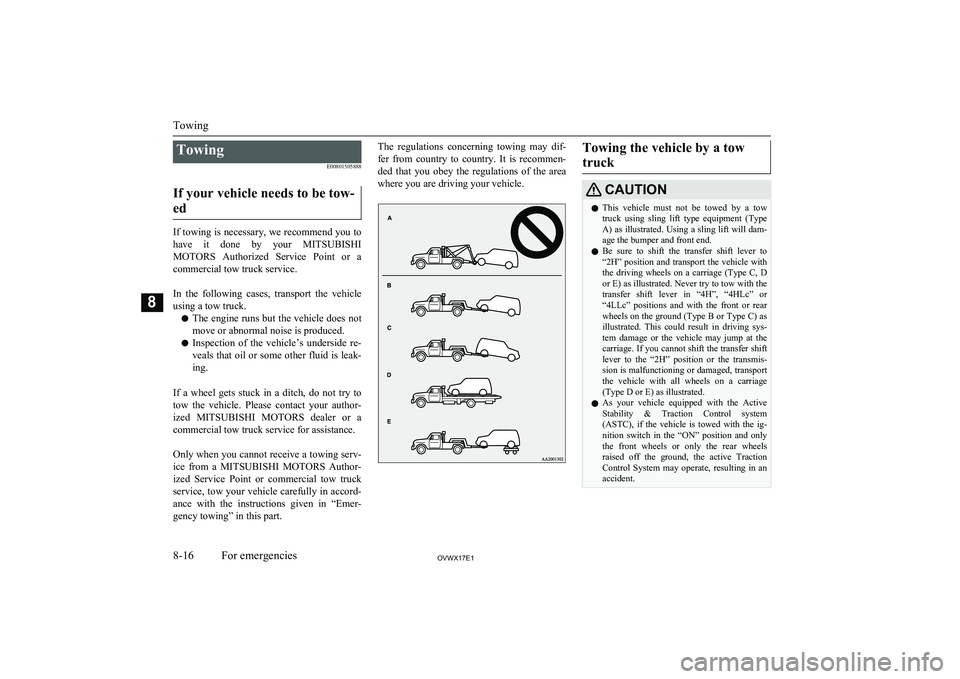
TowingE00801505888
If your vehicle needs to be tow- ed
If towing is necessary, we recommend you to have it done by your MITSUBISHI
MOTORS Authorized Service Point or a
commercial tow truck service.
In the following cases, transport the vehicle
using a tow truck.
l The engine runs but the vehicle does not
move or abnormal noise is produced.
l Inspection of the vehicle’s underside re-
veals that oil or some other fluid is leak- ing.
If a wheel gets stuck in a ditch, do not try to tow the vehicle. Please contact your author-
ized MITSUBISHI MOTORS dealer or a
commercial tow truck service for assistance.
Only when you cannot receive a towing serv-
ice from a MITSUBISHI MOTORS Author-
ized Service Point or commercial tow truck service, tow your vehicle carefully in accord-
ance with the instructions given in “Emer- gency towing” in this part.
The regulations concerning towing may dif-
fer from country to country. It is recommen-
ded that you obey the regulations of the area where you are driving your vehicle.Towing the vehicle by a tow
truckCAUTIONl This vehicle must not be towed by a tow
truck using sling lift type equipment (Type A) as illustrated. Using a sling lift will dam-age the bumper and front end.
l Be sure to shift the transfer shift lever to
“2H” position and transport the vehicle with the driving wheels on a carriage (Type C, D
or E) as illustrated. Never try to tow with the transfer shift lever in “4H”, “4HLc” or “4LLc” positions and with the front or rearwheels on the ground (Type B or Type C) as illustrated. This could result in driving sys-
tem damage or the vehicle may jump at the
carriage. If you cannot shift the transfer shift lever to the “2H” position or the transmis-sion is malfunctioning or damaged, transport the vehicle with all wheels on a carriage
(Type D or E) as illustrated.
l As your vehicle equipped with the Active
Stability & Traction Control system (ASTC), if the vehicle is towed with the ig-
nition switch in the “ON” position and only
the front wheels or only the rear wheels raised off the ground, the active Traction
Control System may operate, resulting in an accident.
Towing
8-16OVWX17E1For emergencies8
Page 309 of 394
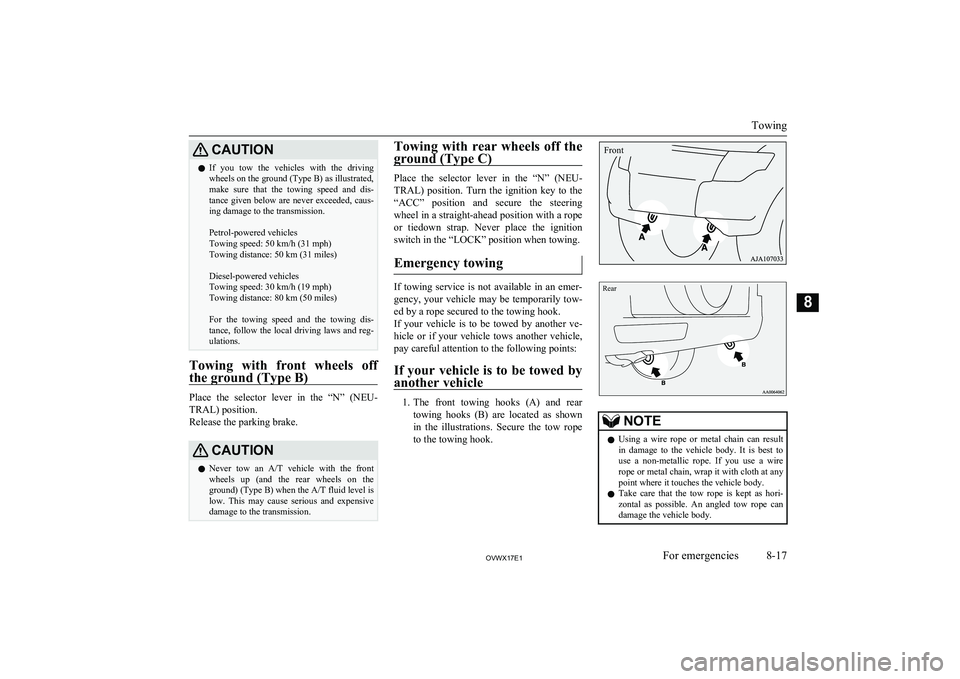
CAUTIONlIf you tow the vehicles with the driving
wheels on the ground (Type B) as illustrated,
make sure that the towing speed and dis-
tance given below are never exceeded, caus-
ing damage to the transmission.
Petrol-powered vehicles
Towing speed: 50 km/h (31 mph)
Towing distance: 50 km (31 miles)
Diesel-powered vehicles
Towing speed: 30 km/h (19 mph)
Towing distance: 80 km (50 miles)
For the towing speed and the towing dis- tance, follow the local driving laws and reg- ulations.
Towing with front wheels off
the ground (Type B)
Place the selector lever in the “N” (NEU-TRAL) position.
Release the parking brake.
CAUTIONl Never tow an
A/T vehicle with the front
wheels up (and the rear wheels on the
ground) (Type B) when the A/T fluid level is low. This may cause serious and expensive damage to the transmission.Towing with rear wheels off the
ground (Type C)
Place the selector lever in the “N” (NEU- TRAL) position. Turn the ignition key to the
“ACC” position and secure the steering wheel in a straight-ahead position with a ropeor tiedown strap. Never place the ignition
switch in the “LOCK” position when towing.
Emergency towing
If towing service is not available in an emer-gency, your vehicle may be temporarily tow-ed by a rope secured to the towing hook.If your vehicle is to be towed by another ve-
hicle or if your vehicle tows another vehicle, pay careful attention to the following points:
If your vehicle is to be towed by
another vehicle
1. The front towing hooks (A) and rear
towing hooks (B) are located as shown
in the illustrations. Secure the tow rope
to the towing hook.
Rear
NOTEl Using a wire rope or metal chain can result
in damage to the vehicle body. It is best to use a non-metallic rope. If you use a wire
rope or metal chain, wrap it with cloth at any
point where it touches the vehicle body.
l Take care that the tow rope is kept as hori-
zontal as possible. An angled tow rope can
damage the vehicle body.
Towing
8-17OVWX17E1For emergencies8 Front
Page 310 of 394
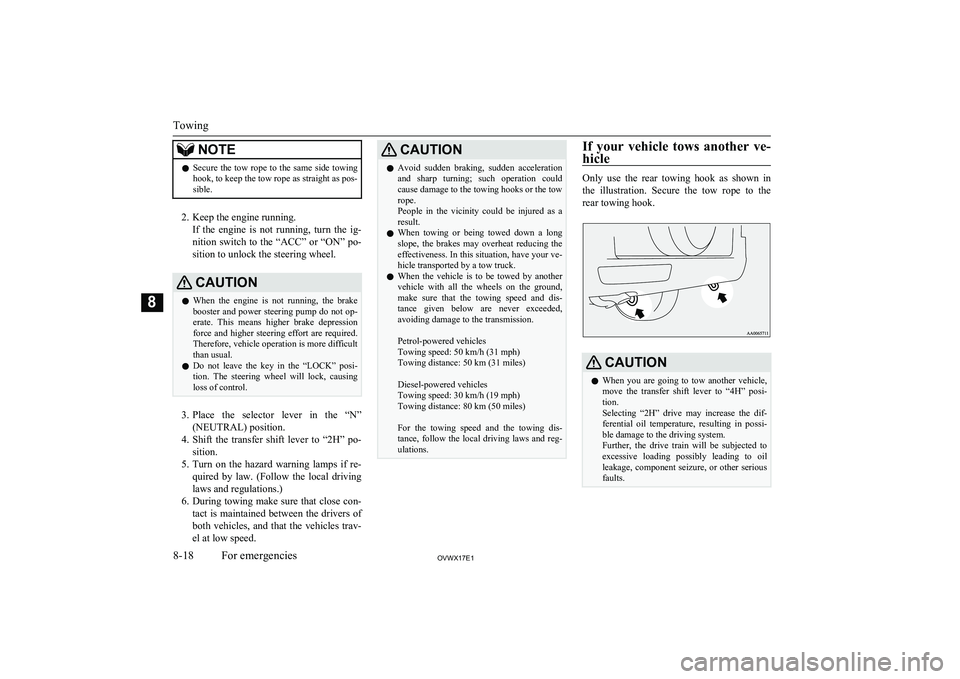
NOTElSecure the tow rope to the same side towing
hook, to keep the tow rope as straight as pos-
sible.
2. Keep the engine running.
If the engine is not running, turn the ig-
nition switch to the “ACC” or “ON” po- sition to unlock the steering wheel.
CAUTIONl When the engine is not running, the brake
booster and power steering pump do not op- erate. This means higher brake depression
force and higher steering effort are required. Therefore, vehicle operation is more difficult
than usual.
l Do not leave the key in the “LOCK” posi-
tion. The steering wheel will lock, causing
loss of control.
3. Place the selector lever in the “N”
(NEUTRAL) position.
4. Shift the transfer shift lever to “2H” po-
sition.
5. Turn on the hazard warning lamps if re-
quired by law. (Follow the local driving
laws and regulations.)
6. During towing make sure that close con-
tact is maintained between the drivers of
both vehicles, and that the vehicles trav- el at low speed.
CAUTIONl Avoid sudden braking, sudden acceleration
and sharp turning; such operation could
cause damage to the towing hooks or the tow
rope.
People in the vicinity could be injured as a
result.
l When towing or being towed down a long
slope, the brakes may overheat reducing the effectiveness. In this situation, have your ve-hicle transported by a tow truck.
l When the vehicle is to be towed by another
vehicle with all the wheels on the ground,make sure that the towing speed and dis-
tance given below are never exceeded,
avoiding damage to the transmission.
Petrol-powered vehicles
Towing speed: 50 km/h (31 mph)
Towing distance: 50 km (31 miles)
Diesel-powered vehicles
Towing speed: 30 km/h (19 mph)
Towing distance: 80 km (50 miles)
For the towing speed and the towing dis- tance, follow the local driving laws and reg- ulations.If your vehicle tows another ve-
hicle
Only use the rear towing hook as shown in
the illustration. Secure the tow rope to the rear towing hook.
CAUTIONl When you are going to tow another vehicle,
move the transfer shift lever to “4H” posi-
tion.
Selecting “2H” drive may increase the dif- ferential oil temperature, resulting in possi-
ble damage to the driving system.
Further, the drive train will be subjected to
excessive loading possibly leading to oil leakage, component seizure, or other serious faults.
Towing
8-18OVWX17E1For emergencies8